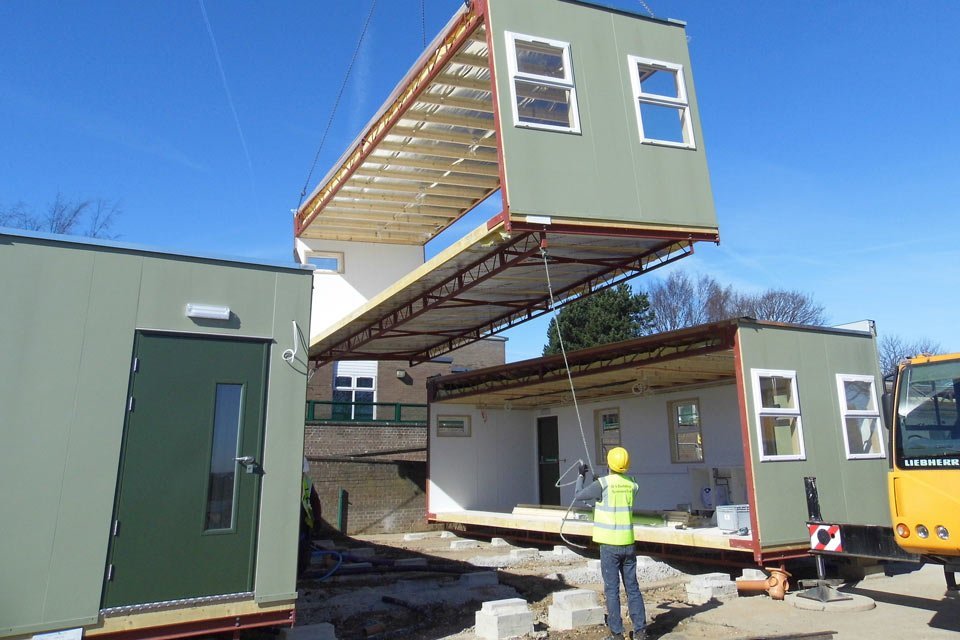If you’ve been considering modular buildings as a structure for your home, storage, office, shop, clinic and so on, we don’t blame you. Modular buildings and modular construction are one of the most sustainable structures from start to finish.
– and how so? Well, these are made with minimal time and energy, plus they’re made with quality material. These are made with less waste and pollution during construction than traditional construction. When it comes to “the end”, these are deconstructed and their parts are then recycled.
Plus they’re much cheaper than traditional construction due to needing less time to finish, less manpower and less clean-up costs after construction. And you can either choose to get temporary modular buildings or permanent ones.
But before you make your decision and pick modular buildings, you need to know what this structure is made out of! There are 3 primary materials commonly used for modular buildings and these are wood, concrete/cement and steel. To know a little bit more about these 3 materials and how they’re used in modular construction– everything is down below!
How is wood used in modular construction?
Wood is a common material used in not only modular construction but also traditional ones. This is an abundant material that is natural, easy to work with and sturdy making it an ideal material to use for construction.
And in modular construction, wood plays a significant role! This is used as a framework and structure, insulation and thermal performance, panels and wall systems and so much more. To give you a little bit more information about how wood is used in modular construction, here is a rundown:
Framework & Structure
The framework and structural elements of modular structures are frequently made of wood. Because of their high strength-to-weight ratios, engineered wood products like glued laminated timber (glulam), laminated veneer lumber (LVL), and cross-laminated timber (CLT) can sustain multistory buildings.
Insulation and Thermal Performance
Because of its natural insulating qualities, wood helps buildings maintain a comfortable temperature and use less energy.
Panels & Wall Systems
In modular buildings, prefabricated wood panels are frequently used. These panels may be produced in a controlled industrial setting off-site, guaranteeing accuracy and high quality.
Interior Finishes
Modular structures make heavy use of wood for interior finishes. This covers the cabinets, wall cladding, flooring, and trim. Modular rooms are cosy and attractive because wood treatments add a cosy and welcoming feel.
Design Flexibility
Wood gives building designers and architects a great deal of creative freedom. Because of their adaptability, modular buildings may be designed to satisfy a variety of practical and aesthetic needs. They are available in a broad range of architectural styles and combinations.
How is concrete/cement used in modular construction?
Another common material used in construction is concrete/cement and it is typically used for the foundation of structures. This is one of the 3 materials commonly used in modular construction and it’s typically used for:
Foundation
For modular constructions, concrete is commonly used to make the foundation. It is possible to make precast concrete foundation elements off-site and then transport them to the construction site for assembly, including footings, piers, and slabs. This approach speeds up the construction schedule while guaranteeing the building’s solidity.
Structural Elements
In modular construction, concrete is sometimes used for building blocks including beams, columns, and shear walls. Strong support and stability may be achieved by merging precast concrete components into modular construction systems that are created off-site.
Fire Resistance
Concrete’s exceptional fire-resistant qualities make it a great option for materials used in construction. To give you an idea, fire separation between modular components or compartments within a building, concrete walls or barriers may be employed.
Exterior Cladding
Precast concrete panels and fibre cement panels are two examples of cement-based materials that are frequently used as outside cladding for modular structures. These panels may be produced in a variety of textures and finishes to improve the building’s visual appeal and offer dependable weather protection.
Flooring Systems
Flooring systems can be constructed out of concrete. For modular constructions, precast concrete floor planks or slabs may be made off-site and swiftly erected to produce sturdy, level flooring.
Utility Infrastructure
Utility infrastructure, including HVAC ducts, water pipes, and electrical conduits, are often housed inside modular buildings using concrete encasements. Essential building systems are supported and protected by these encasements.
How is steel used in modular construction?
Last but not least is steel! This material is commonly used in construction due to its versatility, durability and strength. But to enlighten you on how this material is used in modular construction, here is a rundown:
Structural Framework
Just like wood, steel can also be used for structural framework in construction. Compared to other materials, steel beams, columns, and frames offer robust support for the whole structure, enabling higher structures and wider spans. Because steel frame systems are so strong and lightweight, they are perfect for modular construction, where modules need to be constructed and moved fast.
Exterior Cladding
Steel is used in external cladding systems for modular buildings. For modular constructions, steel panels—typically composed of coated or galvanised steel—offer a strong and weather-resistant external surface.
Chassis for Modules
Individual modules in modular construction are frequently constructed on steel frames or chassis. These steel frameworks enable easy transportation to the building site and give the modules a secure foundation.
Roofing System
Steel is also often used in roofing systems built using modular construction. Purlins, decking, and steel roof trusses together offer structural support and create a sturdy, long-lasting roof assembly. Steel roofing materials have several benefits, including an excellent strength-to-weight ratio, corrosion resistance, and simplicity of installation.
Mechanical System Support
In modular structures, steel is frequently used to support mechanical systems including HVAC (heating, ventilation, and air conditioning) equipment, pipes, and ducting.
Fire Resistance
Another fire-resistant material to consider is steel! Modular building fire safety can be improved by using fire-rated steel structures and components, which protect building occupants and reduce the spread of fire.
Take away
Now you know the 3 commonly used materials in modular construction– you might already have a good understanding of what these are used for. Based on the list above, you can see these 3 materials are USED quite often during modular construction. And no matter what the purpose of usage, even if you’re using these for modular healthcare buildings, storage or even as a cafe, these are still made with the same materials. At least now you don’t have to question the need for these materials.




